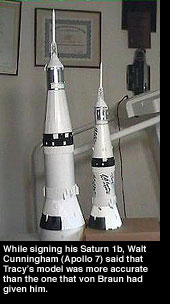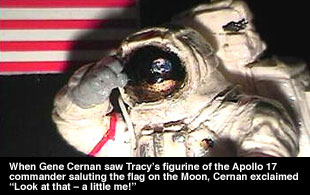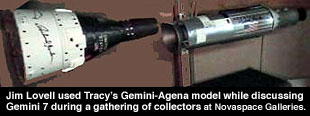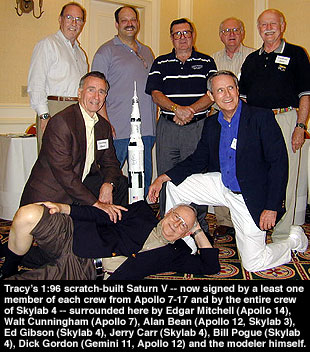Building on our passions
by Tracy Kornfeld
Some call it obsession. Some call it compulsion. Some even call it obsessive compulsion.
I call it passion.
Collectors are very passionate. Whether we're chasing the entire series of signed WSS (White Space Suit) portraits or that elusive GT-3 cover, each of us has that certain Holy Grail and its our passion that drives us forward to find it.
My passion happens to focus on building models of spacecraft from the Mercury, Gemini and Apollo era.
 I don't remember when I started modeling space subjects, but I do remember building my first 1:24 scale Gemini around 1965. And while I may have taken a 20 year hiatus at the close of Apollo, my passion resumed in 1995 without skipping a beat. I don't remember when I started modeling space subjects, but I do remember building my first 1:24 scale Gemini around 1965. And while I may have taken a 20 year hiatus at the close of Apollo, my passion resumed in 1995 without skipping a beat.
I've built the same subjects over and over and over again. Whenever I finish one, I usually see parts that need improving, so I start again.
Passion.
That's not to say that everything is the same as when I was a kid. I now see my hobby with different eyes.
I recently read the following about returning to building models as an adult: "As an adult, you're still fascinated by a lot of the same things you liked as a kid, but on a more sophisticated and rewarding level."
With the Internet giving access to original flight documents and specifications, I have become obsess... err, passionate about accuracy.
It also appears I am not alone.
There is a new crop of modelers so intent on accuracy, that, if a seam doesn't exist on the real vehicle, you won't see it on their models.

Many bring their detailing down to the rivet level, using dental tools and computer generated decals. They fashion custom parts out of a myriad of items, such as insulin bottle caps, textured adhesive tape, and epoxy putty after spending hours and hours reading and researching the subject at hand.
This is what we call fun.
I consider myself at best, a fair modeler. Witnessing the scratch built works of the real experts can be quite impressive if not humbling. Its very easy to develop 'skill-envy' of the other, more experienced modelers.
That said, you don't need to be a, well, rocket scientist to scale model. They're easy to build right out of the box. All you need is a model kit, glue, paint, a paintbrush, a hobby knife and a few hours to kill and you'll have your first model finished in no time. Budget wise, you can spend as little as $15.00 to get started.
As you become more passionate about the hobby, you are bound to notice some inaccuracies.
An overwhelming majority of the model kits of early spacecraft were based on McDonnell, North American or Grumman prototype designs rather than the flight article. With relatively few exceptions, these same molds are still used today as older space kits are reissued.

Take for example, the Gemini kits: based on the contractor's prototype, they have incorrect window scalloping and include the original paraglider landing skids -- even though this type of landing option was cancelled in 1964.
All but one of the Apollo kits are based on the original Block I design and have inaccurate detailing on both the Command Module (CM) and Service Module (SM), assuming you want to build the flight configuation.
Even today, most of the Saturn V box art and assembly instructions continues to illustrate the paint pattern from the non-flight 500-F Saturn V test article (this particular error also plagued digital modelers creating the Saturn V for the movie "Apollo 13").
These errors have created a spin-off industry of garage kits that correct commercial releases' mistakes and/or add missing details. Production for these add-ons most often takes place -- quite literally -- in some hobbyist's garage or spare room. As such, these kits are usually available in very short production runs, and when they're gone, they're gone.

My personal collection includes various US and Soviet launch vehicles in scales from 1:48 to 1:288; Mercury, Gemini, Apollo, Voshkod and Soyuz spacecraft in scales from 1:24 to 1:144; Mir and the ISS with Shuttle, Soyuz and Progress in 1:144; and EVA space figurines in 1:32 scale.
One day, I hope to build a complete lunar landing diorama with the Apollo CSM, Lunar Module and astronaut figures in 1:32 and/or 1:48 scale.
I also hope to build the entire Saturn V stack in 1:48 scale, approximately 8 feet tall! I have the plans, I just have to summon up the courage to actually start building.
I have no doubt that I will though... my passion is too strong.
|

 I don't remember when I started modeling space subjects, but I do remember building my first 1:24 scale Gemini around 1965. And while I may have taken a 20 year hiatus at the close of Apollo, my passion resumed in 1995 without skipping a beat.
I don't remember when I started modeling space subjects, but I do remember building my first 1:24 scale Gemini around 1965. And while I may have taken a 20 year hiatus at the close of Apollo, my passion resumed in 1995 without skipping a beat.

